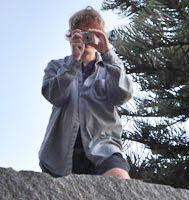
In this section I consider how well the camera works in low-light situations. Given the SX110's image stabilization, the hope is to get relatively low-noise, low-blur shots without having to use a tripod. In general it does well on the low-blur criteria, but not so well on noise.
At right you can see a hand-held shot with image stabilization on, at ISO 80, with a 1/1.3 second exposure (~0.7s). I have a pretty steady hand, but even I was surprised to see how little blur there was in the photo. The SX110's image stabilization works amazingly well. Shift-click on the photo to view it full-sized, however, and you will see that there is definitely both blur (unsurprising for a ~0.7s exposure!) and CCD noise (a bit disappointing, but the light level is quite low).
 This photo was taken at ISO 200, with a 1/3.3s exposure. Already, things are much better. The unzoomed photo at right actually looks quite sharp, but if you click on it for the full sized version you will see that there still is some blur. CCD noise is worse, but not much.
This photo was taken at ISO 200, with a 1/3.3s exposure. Already, things are much better. The unzoomed photo at right actually looks quite sharp, but if you click on it for the full sized version you will see that there still is some blur. CCD noise is worse, but not much.
Next, I turned off image stabilization, and used the same ISO/exposure (200,1/3.3s). As you can see, the result is quite blurry, perhaps even without viewing the image full size. Note, just how much blur you would get in this situation would vary by user and chance, since it all depends on how firm and steady your hand is. Any way you cut it, however, you can see that image stabilization is buying you a lot.

With image stabilization back on, I raised the ISO to 400, with a 1/6s exposure. The result seems to be slightly more resolvable detail, if you view the image full screen. For instance, try to read the text on the pill bottle. The amount of noise, unfortunately, also goes up, though this is only really noticeable if you zoom all the way into 1:1 pixels, or if you have a really, really huge monitor (the image is 9 megapixels, which is 3456 x 2592).

Next up is ISO 800, with 1/13s exposure. Now the CCD nosie is significantly higher, and the level of detail doesn't seem to have improved at all. This ISO level might be useful if you have shakey hands, or a faster-moving subject than my desktop still-life pictured here. Otherwise, I would stick to ISO 400 or below.
In conclusion, the image stabilization works great. You can get good low-light shots even at ISO 200. Unfortunately, the CCD noise is pretty high - higher than I would have guessed given the size of the lens (which allows more light to enter the camera, which should, in theory, result in less noise). This is not as big a deal, however, if you don't need all 9MP of resolution. Viewing the photos on my 1280x1024 monitor, CCD noise only became objectionable at ISO 800. While monitors will continue to grow in resolution, it's going to be quite a while before even a few of us have 3456 x 2592 displays where you could actually display each pixel of a 9MP image. The other important point to keep in mind is that the actual ISO is pretty unimportant in the end: what you care about is whether you can get good low-blur, high-detail images without using the flash. If ISO 200 is good enough for that, who cares if some noise creeps into ISO 400.
This post is part of a series that reviews the Canon SX110IS.

No comments:
Post a Comment